Monitoring Changes in Croplands Due to Water Stress in the Krishna River Basin Using Temporal Satellite Imagery
Abstract
1. Introduction
2. Materials and Methods
2.1. Study Area
2.2. Satellite Data
2.3. Ground Survey Data
2.4. National Statistics & Secondary Data
2.5. Mapping Land Use/Land Cover
2.6. Water Stress Mapping and Categorization
3. Results
3.1. Spatial Distribution of LULC
3.2. Water Scarcity and Cropland Changes
3.3. Accuracy Assessment and Comparison with Other Published Data Sets
4. Discussion
5. Conclusions
Acknowledgments
Author Contributions
Conflicts of Interest
References
- Biggs, T.W.; Gangadhara Rao, P.; Bharati, L. Mapping agricultural responses to water supply shocks in large irrigation systems, southern India. Agric. Water Manag. 2010, 97, 924–932. [Google Scholar] [CrossRef]
- Gumma, M.K. Methods and Approaches for Irrigated Area Mapping at Various Spatial Resolutions Using AVHRR, MODIS and LANDSAT ETM+ Data for the Krishna River Basin, India. Ph.D. Dissertation, Jawaharlal Nehru Technological University, Hyderabad, India, 2008. Available online: http://publications.iwmi.org/pdf/H042567.pdf (accessed on 21 August 2015).
- Gumma, M.K.; Thenkabail, P.S.; Muralikrishna, I.V.; Velpuri, M.N.; Gangadhararao, P.T.; Dheeravath, V.; Biradar, C.M.; Acharya Nalan, S.; Gaur, A. Changes in agricultural cropland areas between a water-surplus year and a water-deficit year impacting food security, determined using MODIS 250 m time-series data and spectral matching techniques, in the Krishna river basin (India). Int. J. Remote Sens. 2011, 32, 3495–3520. [Google Scholar] [CrossRef]
- Gaur, A.; Biggs, T.W.; Gumma, M.K.; Parthasaradhi, G.R.; Turral, H. Water scarcity effects on equitable water distribution and land use in major irrigation project—A case study in India. J. Irrig. Drain. Eng. 2008, 134, 26–35. [Google Scholar] [CrossRef]
- Anderson, J.R. A Land Use and Land Cover Classification System for Use with Remote Sensor Data; US Government Printing Office: Washington, DC, USA, 1976; Volume 964.
- Gumma, M.; Pyla, K.; Thenkabail, P.; Reddi, V.; Naresh, G.; Mohammed, I.; Rafi, I. Crop dominance mapping with IRS-P6 and MODIS 250-m time series data. Agriculture 2014, 4, 113–131. [Google Scholar] [CrossRef]
- Gumma, M.K.; Thenkabail, P.S.; Hideto, F.; Nelson, A.; Dheeravath, V.; Busia, D.; Rala, A. Mapping irrigated areas of Ghana using fusion of 30 m and 250 m resolution remote-sensing data. Remote Sens. 2011, 3, 816–835. [Google Scholar] [CrossRef]
- Gumma, M.K.; Thenkabail, P.S.; Teluguntla, P.; Rao, M.N.; Mohammed, I.A.; Whitbread, A.M. Mapping rice-fallow cropland areas for short-season grain legumes intensification in South Asia using MODIS 250 m time-series data. Int. J. Digit. Earth 2016, 9, 981–1003. [Google Scholar] [CrossRef]
- World Meteorological Organization Press Release, 25-01-16. Available online: https://public.wmo.int/en (accessed on 21 August 2015).
- Singh, A. Review article digital change detection techniques using remotely-sensed data. Int. J. Remote Sens. 1989, 10, 989–1003. [Google Scholar] [CrossRef]
- Wan, Z.; Wang, P.; Li, X. Using modis land surface temperature and normalized difference vegetation index products for monitoring drought in the southern Great Plains, USA. Int. J. Remote Sens. 2004, 25, 61–72. [Google Scholar] [CrossRef]
- Hao, Z.; Hao, F.; Singh, V.P. A general framework for multivariate multi-index drought prediction based on Multivariate Ensemble Streamflow Prediction (MESP). J. Hydrol. 2016, 539, 1–10. [Google Scholar] [CrossRef]
- Li, Z.; Hao, Z.; Shi, X.; Déry, S.J.; Li, J.; Chen, S.; Li, Y. An agricultural drought index to incorporate the irrigation process and reservoir operations: A case study in the Tarim river basin. Glob. Planet. Chang. 2016, 143, 10–20. [Google Scholar] [CrossRef]
- Olsson, P.-O.; Lindström, J.; Eklundh, L. Near real-time monitoring of insect induced defoliation in subalpine birch forests with MODIS derived NDVI. Remote Sens. Environ. 2016, 181, 42–53. [Google Scholar] [CrossRef]
- Wang, J.; Ling, Z.; Wang, Y.; Zeng, H. Improving spatial representation of soil moisture by integration of microwave observations and the temperature–vegetation–drought index derived from MODIS products. ISPRS J. Photogramm. Remote Sens. 2016, 113, 144–154. [Google Scholar] [CrossRef]
- Yaduvanshi, A.; Srivastava, P.K.; Pandey, A.C. Integrating TRMM and MODIS satellite with socio-economic vulnerability for monitoring drought risk over a tropical region of India. Phys. Chem. Earth Parts A/B/C 2015, 83–84, 14–27. [Google Scholar] [CrossRef]
- Badhwar, G.D. Automatic corn-soybean classification using landsat MSS data. I. Near-harvest crop proportion estimation. Remote Sens. Environ. 1984, 14, 15–29. [Google Scholar] [CrossRef]
- Thiruvengadachari, S.; Sakthivadivel, R. Satellite Remote Sensing for Assessment of Irrigation System Performance: A Case Study in India; Research Report 9; International Irrigation Management Institute: Colombo, Sri Lanka, 1997. [Google Scholar]
- Gumma, M.K.; Gauchan, D.; Nelson, A.; Pandey, S.; Rala, A. Temporal changes in rice-growing area and their impact on livelihood over a decade: A case study of Nepal. Agric. Ecosyst. Environ. 2011, 142, 382–392. [Google Scholar] [CrossRef]
- Biggs, T.W.; Thenkabail, P.S.; Gumma, M.K.; Scott, C.A.; Parthasaradhi, G.R.; Turral, H.N. Irrigated area mapping in heterogeneous landscapes with MODIS time series, ground truth and census data, Krishna Basin, India. Int. J. Remote Sens. 2006, 27, 4245–4266. [Google Scholar] [CrossRef]
- Thenkabail, P.S.; Biradar, C.M.; Noojipady, P.; Dheeravath, V.; Li, Y.; Velpuri, M.; Gumma, M.; Gangalakunta, O.R.P.; Turral, H.; Cai, X.; et al. Global irrigated area map (GIAM), derived from remote sensing, for the end of the last millennium. Int. J. Remote Sens. 2009, 30, 3679–3733. [Google Scholar] [CrossRef]
- Bhutta, M.N.; Van der Velde, E.J. Equity of water distribution along secondary canals in Punjab, Pakistan. Irrig. Drain. Syst. 1992, 6, 161–177. [Google Scholar] [CrossRef]
- Teluguntla, P.; Ryu, D.; George, B.; Walker, J.P.; Malano, H.M. Mapping flooded rice paddies using time series of MODIS imagery in the Krishna River Basin, India. Remote Sens. 2015, 7, 8858–8882. [Google Scholar] [CrossRef]
- Dheeravath, V.; Thenkabail, P.S.; Chandrakantha, G.; Noojipady, P.; Reddy, G.P.O.; Biradar, C.M.; Gumma, M.K.; Velpuri, M. Irrigated areas of India derived using MODIS 500 m time series for the years 2001–2003. ISPRS J. Photogramm. Remote Sens. 2010, 65, 42–59. [Google Scholar] [CrossRef]
- Gumma, M.K.; Mohanty, S.; Nelson, A.; Arnel, R.; Mohammed, I.A.; Das, S.R. Remote sensing based change analysis of rice environments in Odisha, India. J. Environ. Manag. 2015, 148, 31–41. [Google Scholar] [CrossRef] [PubMed]
- Gumma, M.K.; Nelson, A.; Thenkabail, P.S.; Singh, A.N. Mapping rice areas of South Asia using MODIS multitemporal data. J. Appl. Remote Sens. 2011, 5, 053547. [Google Scholar] [CrossRef]
- Thenkabail, P.S.; Schull, M.; Turral, H. Ganges and Indus river basin land use/land cover (LULC) and irrigated area mapping using continuous streams of MODIS data. Remote Sens. Environ. 2005, 95, 317–341. [Google Scholar] [CrossRef]
- Gumma, M.K.; Thenkabail, P.S.; Maunahan, A.; Islam, S.; Nelson, A. Mapping seasonal rice cropland extent and area in the high cropping intensity environment of Bangladesh using MODIS 500 m data for the year 2010. ISPRS J. Photogramm. Remote Sens. 2014, 91, 98–113. [Google Scholar] [CrossRef]
- Thenkabail, P.S.; Stucky, N.; Griscom, B.W.; Ashton, M.S.; Diels, J.; Van Der Meer, B.; Enclona, E. Biomass estimations and carbon stock calculations in the oil palm plantations of African derived savannas using IKONOS data. Int. J. Remote Sens. 2004, 25, 5447–5472. [Google Scholar] [CrossRef]
- Gumma, M.K.; Thenkabail, P.S.; Nelson, A. Mapping irrigated areas using MODIS 250 meter time-series data: A study on Krishna River Basin (India). Water 2011, 3, 113–131. [Google Scholar] [CrossRef]
- Indiastat, Agriculture Statistics, Socio-Economic Statistical Information about India. Available online: https://www.indiastat.com/agriculture/2/stats.aspx (accessed on 15 January2015).
- TRMM, Tropical Rainfall Measuring Mission. Available online: http://trmm.Gsfc.Nasa.Gov/ (accessed on 10 January 2016).
- Gumma, M.K.; Nelson, A.; Yanano, T. Mapping drought-induced changes in rice area in India. (Unpublished work).
- Huete, A.; Didan, K.; Miura, T.; Rodriguez, E.P.; Gao, X.; Ferreira, L.G. Overview of the radiometric and biophysical performance of the MODIS vegetation indices. Remote Sens. Environ. 2002, 83, 195–213. [Google Scholar] [CrossRef]
- Holben, B.N. Characteristics of maximum-value composite images from temporal AVHRR data. Int. J. Remote Sens. 1986, 7, 1417–1434. [Google Scholar] [CrossRef]
- Cihlar, J. Land cover mapping of large areas from satellites: Status and research priorities. Int. J. Remote Sens. 2000, 21, 1093–1114. [Google Scholar] [CrossRef]
- Thenkabail, P.S.; GangadharaRao, P.; Biggs, T.; Gumma, M.K.; Turral, H. Spectral matching techniques to determine historical land use/land cover (LULC) and irrigated areas using time-series AVHRR pathfinder datasets in the Krishna River Basin, India. Photogramm. Eng. Remote Sens. 2007, 73, 1029–1040. [Google Scholar]
- Tomlinson, R. Thinking about Geographic Information Systems Planning for Managers; ESRI Press: Redlands, CA, USA, 2003; p. 283. [Google Scholar]
- Gumma, M.K.; Kajisa, K.; Mohammed, I.A.; Whitbread, A.M.; Nelson, A.; Rala, A.; Palanisami, K. Temporal change in land use by irrigation source in Tamil Nadu and management implications. Environ. Monit. Assess. 2015, 187, 1–17. [Google Scholar] [CrossRef] [PubMed][Green Version]
- Congalton, R.; Green, K. Assessing the Accuracy of Remotely Sensed Data: Principles and Practices; Lewis: New York, NY, USA, 1999. [Google Scholar]
- Congalton, R.G.; Green, K. Assessing the Accuracy of Remotely Sensed Data: Principles and Practices, 2nd ed.; CRC Press: New York, NY, USA, 2008. [Google Scholar]
- Jensen, J.R. Introductory Digital Image Processing: A Remote Sensing Perspective; Prentice Hall PTR: Upper Saddle River, NJ, USA, 1996. [Google Scholar]
- Congalton, R.G. Remote sensing and geographic information system data integration: Error sources and research issues. Photogramm. Eng. Remote Sens. 1991, 57, 677–687. [Google Scholar]
- Jensen, J.R. Introductory Digital Image Processing: A Remote Sensing Perspective, 3rd ed.; Prentice Hall PTR: Upper Saddle River, NJ, USA, 2004; p. 544. [Google Scholar]
- Raghu, P.; Lall, B.K. Drought 2015-16, Lessons from Desolation; Action Aid India: New Delhi, India, 2016. [Google Scholar]
- Ministry of Agriculture and Farmers Welfare. Annual Report 2015–16. Available online: http://agricoop.nic.in/sites/default/files/Final%20Annual%20Report%20English.pdf (accessed on 1 september 2017).
- Reservoir Storage Monitoring System, Government of AndhraPradesh. Available online: http://cadarsms.cgg.gov.in/Login.do?link=5&langlink (accessed on 30 August 2017).
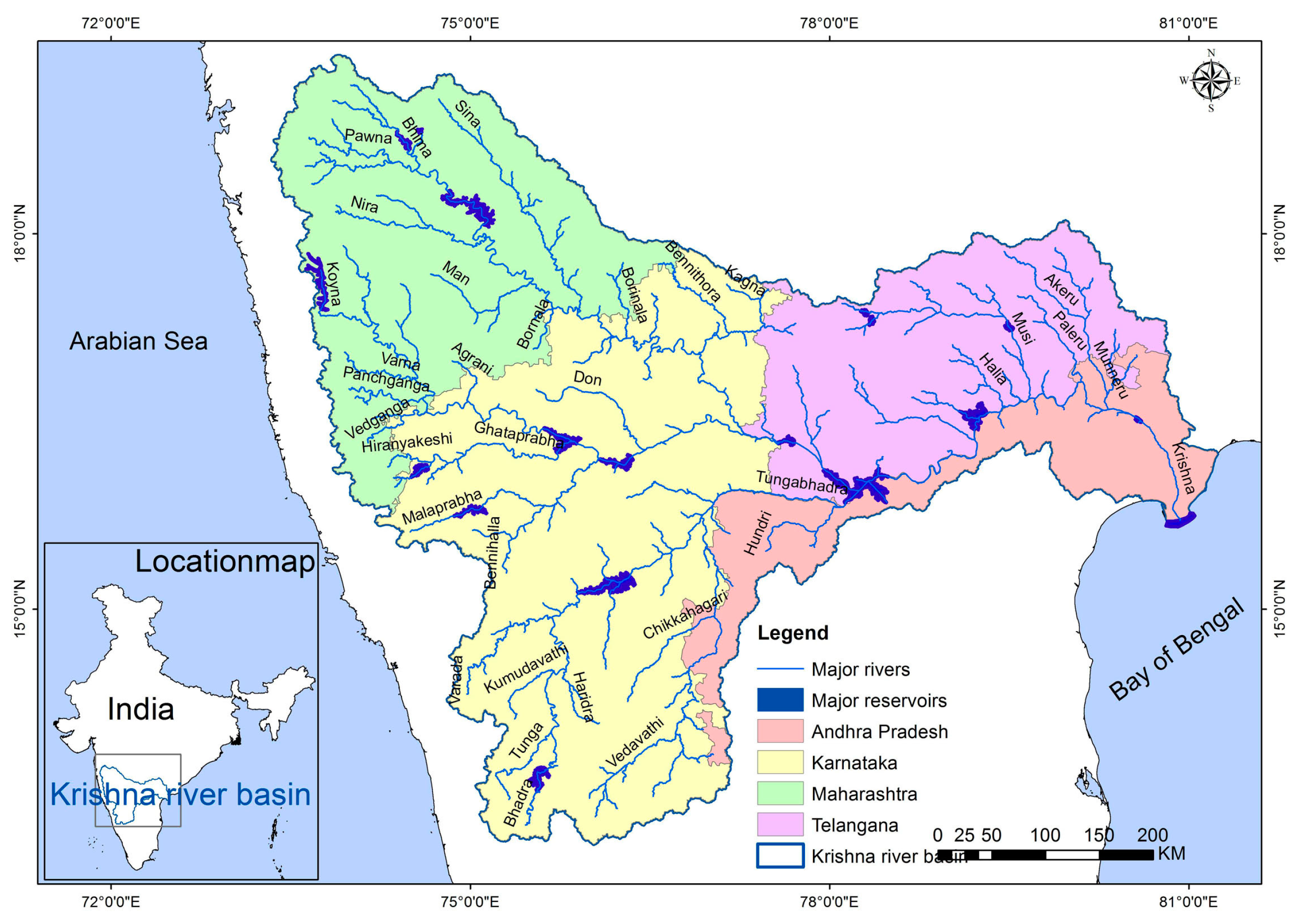
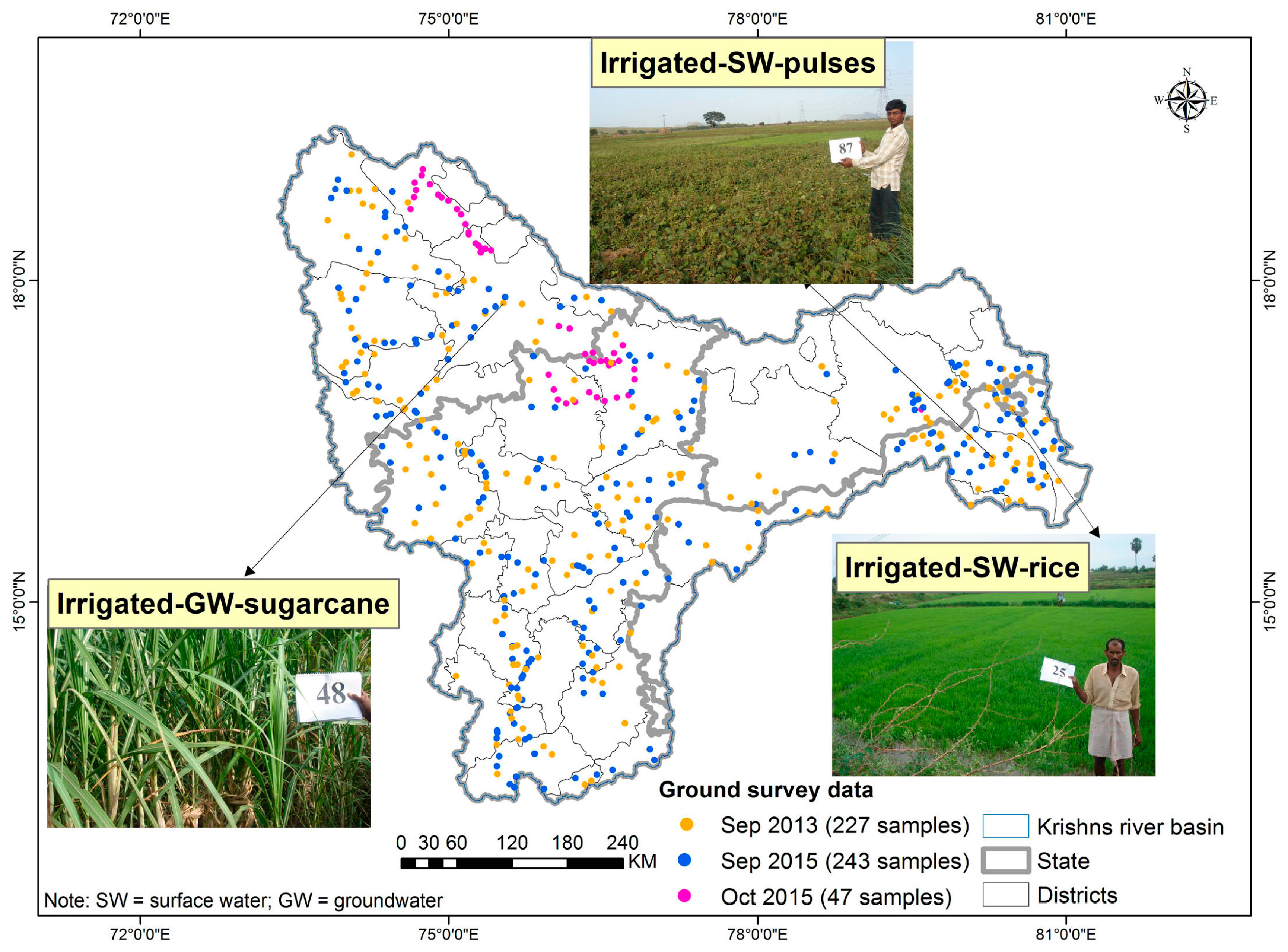

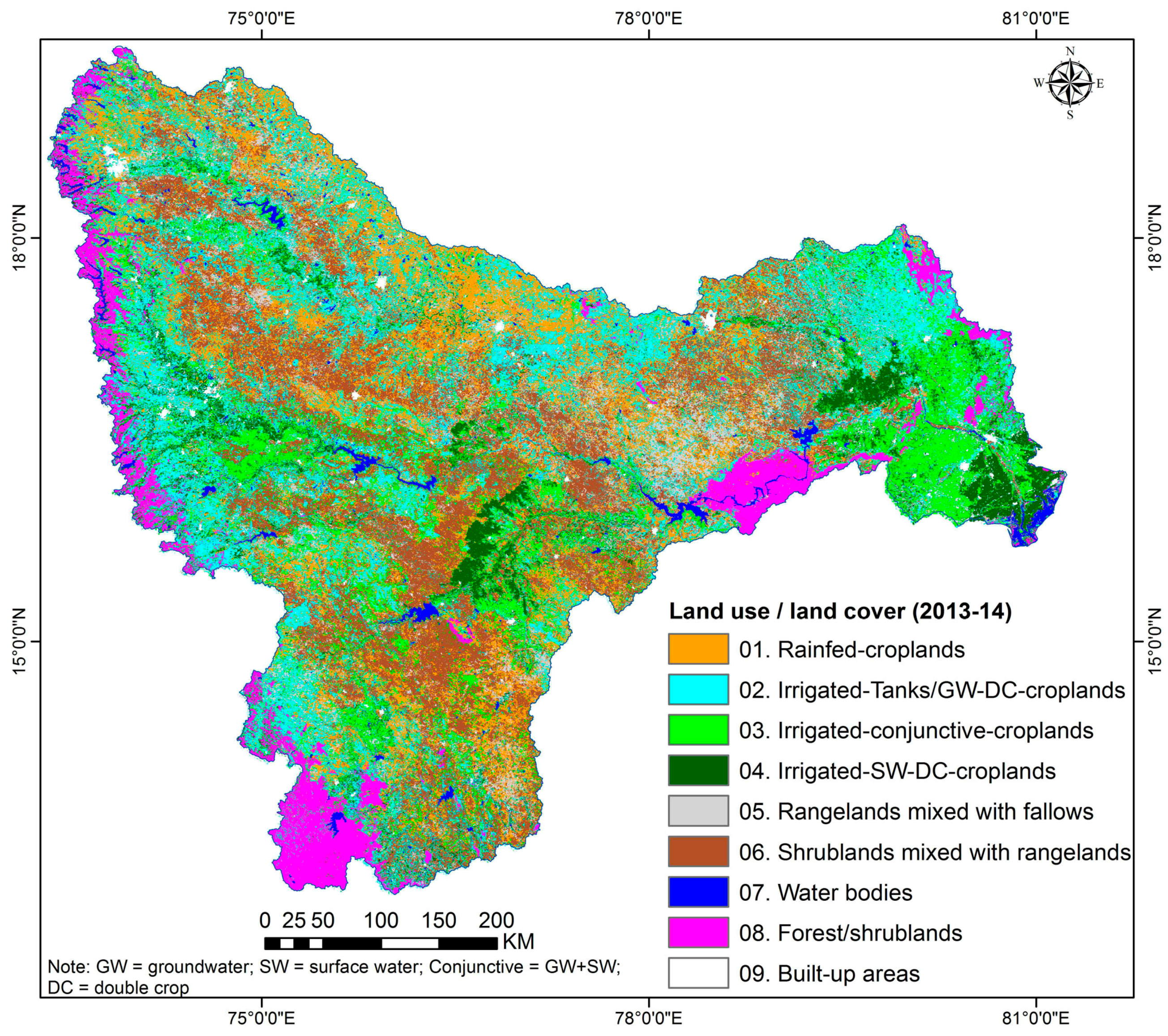

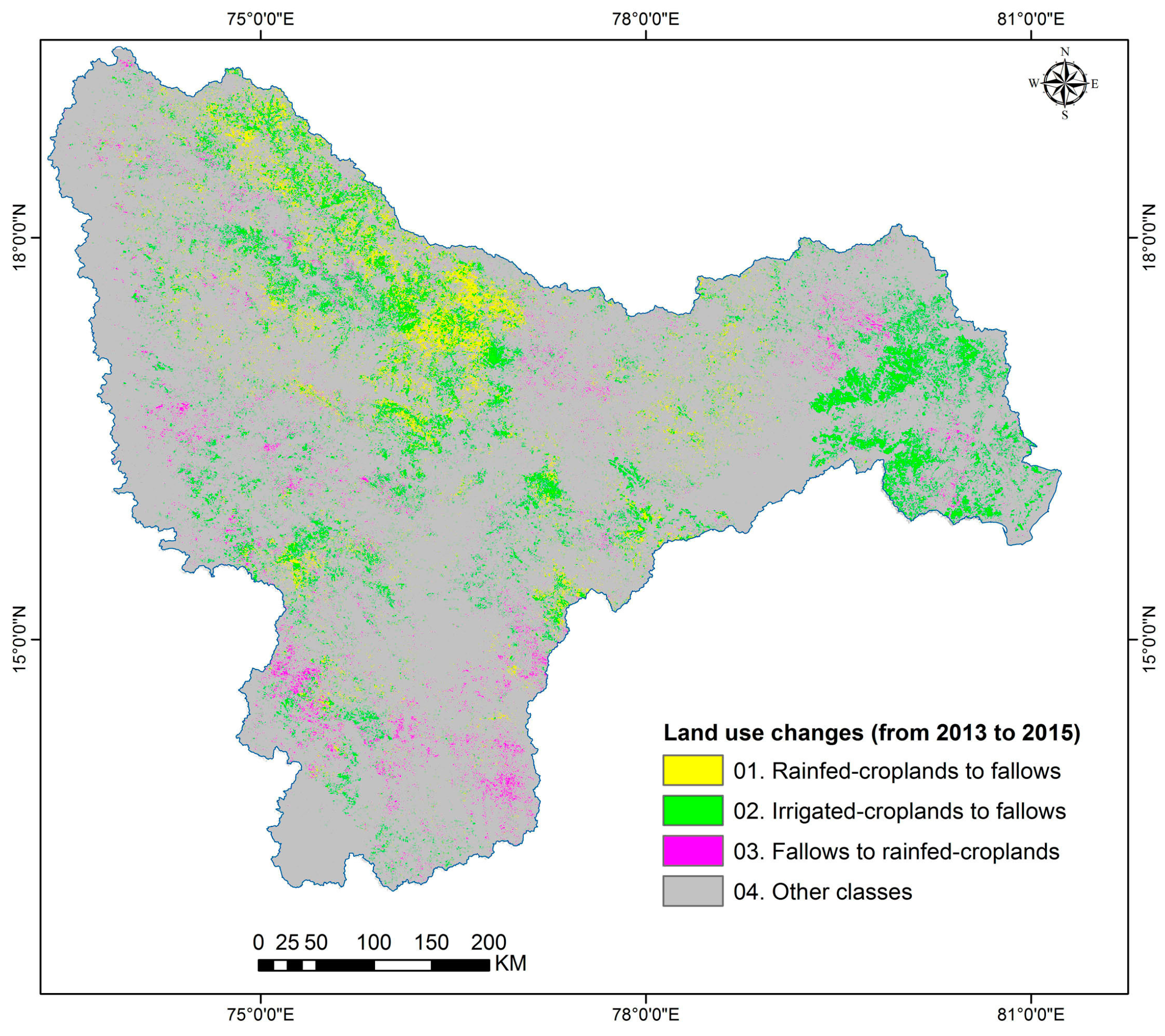
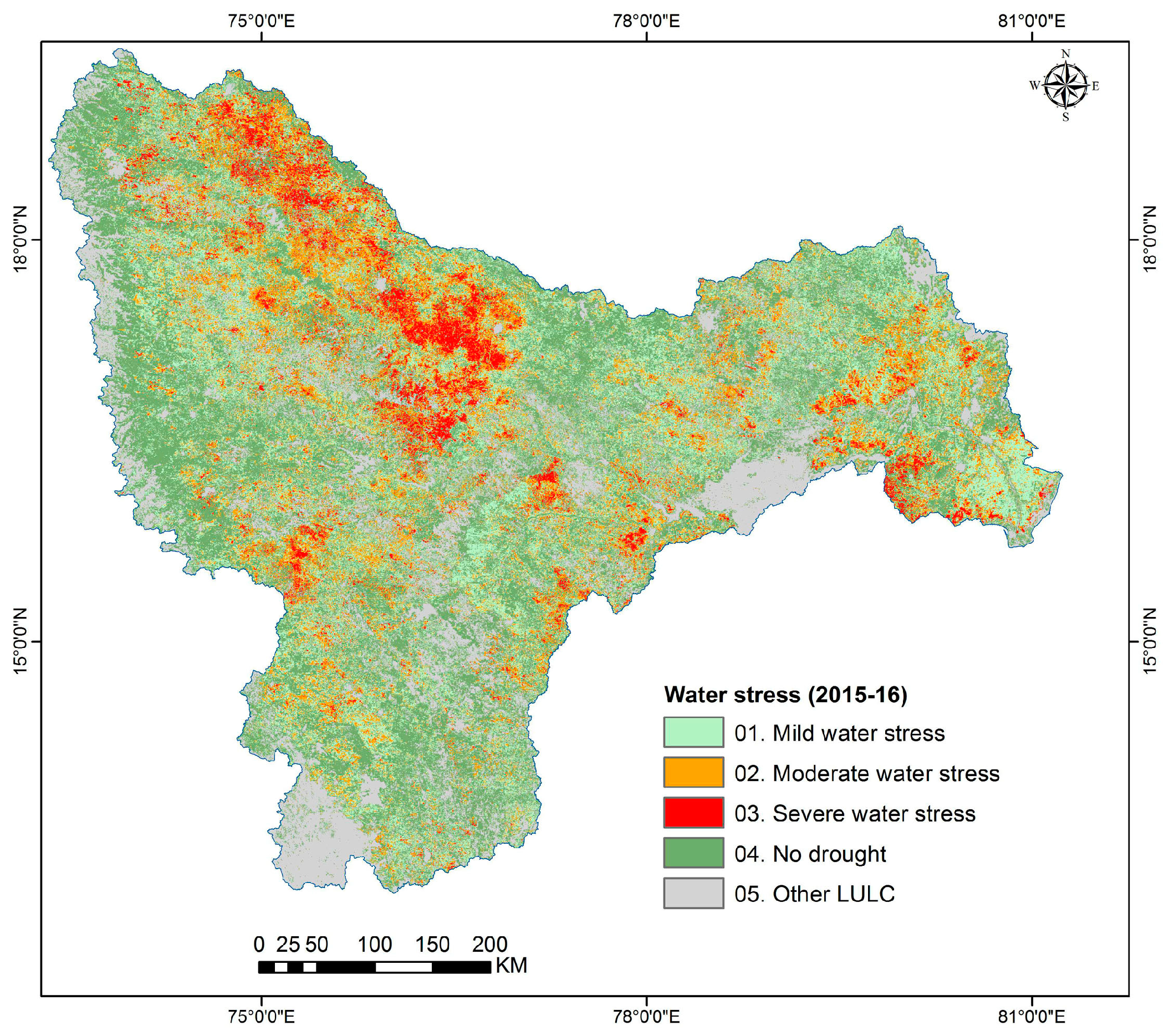

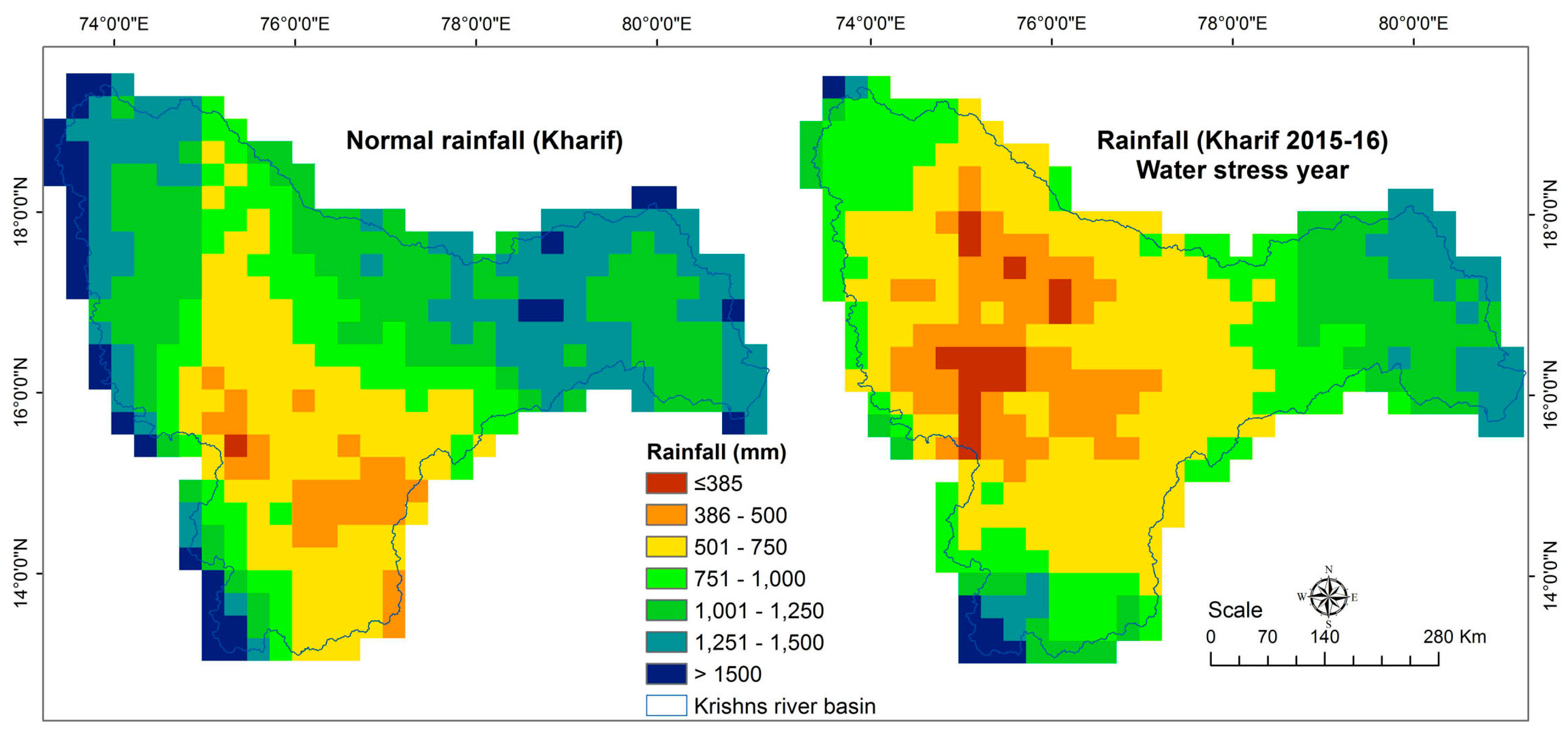
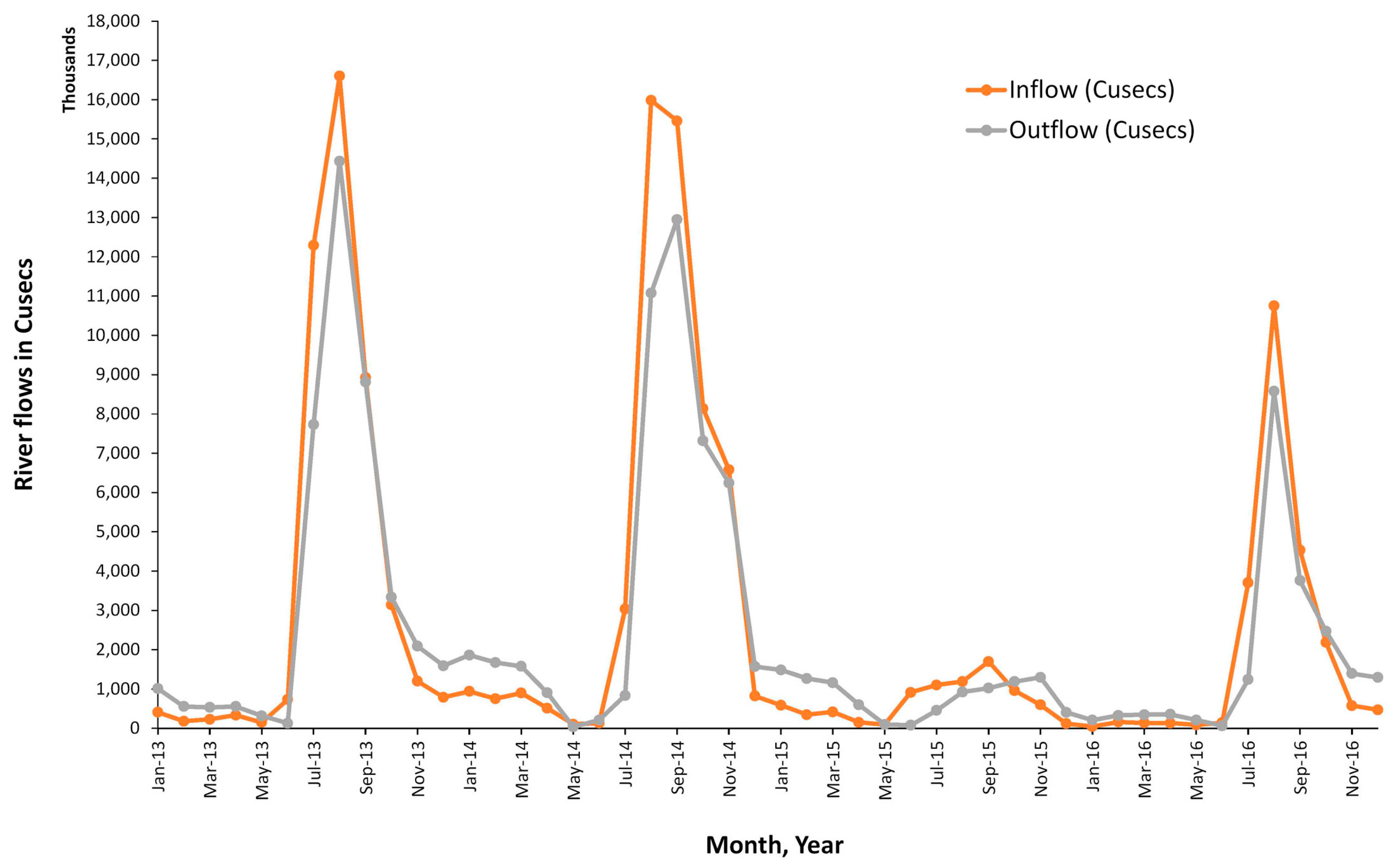
| MODIS Data Sets | Units | Band Width nm/Range | Potential Application |
|---|---|---|---|
| 250 m 16 days NDVI | NDVI | −1 to +1 | Vegetation conditions |
| 250 m 16 days EVI | EVI | −1 to +1 | Canopy structural variations |
| 250 m 16 days red reflectance (Band 1) | Reflectance | 620–670 | Absolute land cover transformation, Vegetation chlorophyll |
| 250 m 16 days NIR reflectance (Band 2) | Reflectance | 841–876 | Cloud amount, vegetation land cover transformation |
| 250 m 16 days blue reflectance (Band 3) | Reflectance | 459–479 | Soil/vegetation differences |
| 250 m 16 days MIR reflectance (Band 7) | Reflectance | 2105–2155 | Cloud properties, land properties |
| LULC | Full Pixel Area (FPA) (000′ha) | Crop Area Fraction (%) | Actual Cropland Area (000′ha) | |||
|---|---|---|---|---|---|---|
| 2013–2014 | 2015–2016 | 2013–2014 | 2015–2016 | 2013–2014 | 2015–2016 | |
| 01. Rainfed croplands | 4853.5 | 3972.9 | 84.2 | 70.5 | 4087.4 | 2801.7 |
| 02. Irrigated-Tanks/GW-DC-croplands | 5896.8 | 5112.9 | 86.5 | 76.3 | 5102.3 | 3900.5 |
| 03. Irrigated-conjunctive-croplands | 3196.9 | 2795.2 | 89.2 | 83.6 | 2852.1 | 2335.9 |
| 04. Irrigated-SW-DC-croplands | 1726.5 | 1477.1 | 92.6 | 86.1 | 1598.7 | 1271.8 |
| 05. Rangelands mixed with fallows | 2678.2 | 5730.9 | 21.5 | 12.5 | 576.9 | 713.8 |
| 06. Shrublands mixed with rangelands | 5587.8 | 4886.8 | 8.5 | 9.1 | 472.6 | 444.7 |
| 07. Water bodies | 458.2 | 440.7 | - | - | 458.2 | 440.7 |
| 08. Forests/shrublands | 1949.1 | 1940.8 | - | - | 1949.1 | 1940.8 |
| 09. Built-up areas | 305.6 | 298.5 | - | - | 305.6 | 298.5 |
| Net irrigated area | - | - | - | - | 9553.1 | 7508.2 |
| Net agriculture area | - | - | - | - | 14,690.0 | 11,468.5 |
| Water Stress Class | Full Pixel Area (FPA) (000′ha) | Cropland Fraction (%) | Actual Cropland Area (000′ha) |
|---|---|---|---|
| 01. Mild water stress | 5209.8 | 81.1 | 4226 |
| 02. Moderate water stress | 3013.2 | 78.1 | 2355 |
| 03. Severe water stress | 1125.1 | 88.1 | 991 |
| 04. No water stress | 8409.9 | 84.7 | 7120 |
| 05. Other LULC | 9013.2 | - | 9013 |
| Total water stress area | - | - | 7572 |
| Water Stress Class | 01. Mild Water Stress | 02. Moderate Water Stress | 03. Severe Water Stress | |
| Full pixel area (FPA) (000′ha) | 01. Rainfed-croplands | 1327 | 1030 | 482 |
| 02. Irrigated-Tanks/GW-DC-croplands | 1968 | 1092 | 355 | |
| 03. Irrigated-conjunctive-croplands | 1160 | 580 | 183 | |
| 04. Irrigated-SW-DC-croplands | 755 | 310 | 105 | |
| Cropland Fraction (%) | 81.1 | 78.1 | 88.1 | |
| Actual Cropland area (000′ha) | 01. Rainfed-croplands | 1076 | 805 | 425 |
| 02. Irrigated-Tanks/GW-DC-croplands | 1596 | 854 | 313 | |
| 03. Irrigated-conjunctive-croplands | 941 | 454 | 161 | |
| 04. Irrigated-SW-DC-croplands | 612 | 242 | 93 | |
| LULC | Reference Data | Reference | Classified | Number | Producers | Users | Kappa | ||||||
|---|---|---|---|---|---|---|---|---|---|---|---|---|---|
| 01. | 02. | 03. | 04. | 05. | 06. | Totals | Totals | Correct | Accuracy | Accuracy | |||
| MODIS-derived classification | 01. Rainfed croplands | 10 | 3 | 0 | 0 | 0 | 1 | 15 | 14 | 10 | 67% | 71% | 68% |
| 02. Irrigated-Tanks/GW-DC-croplands | 1 | 23 | 3 | 1 | 1 | 0 | 31 | 29 | 23 | 74% | 79% | 74% | |
| 03. Irrigated-conjunctive-croplands | 1 | 2 | 28 | 1 | 0 | 0 | 35 | 32 | 28 | 80% | 88% | 84% | |
| 04. Irrigated-SW-DC-croplands | 0 | 0 | 1 | 19 | 0 | 0 | 23 | 20 | 19 | 83% | 95% | 94% | |
| 05. Rangelands mixed with fallows | 2 | 1 | 2 | 1 | 10 | 0 | 12 | 16 | 10 | 83% | 63% | 59% | |
| 06. Other LULC | 1 | 2 | 1 | 1 | 1 | 35 | 36 | 41 | 35 | 97% | 85% | 81% | |
| Total | 15 | 31 | 35 | 23 | 12 | 36 | 152 | 152 | 125 | ||||
| Overall Classification Accuracy = 82.24% | Overall Kappa Statistics = 0.7811 | ||||||||||||
| LULC | Reference Data | Reference | Classified | Number | Producers | Users | Kappa | ||||||
|---|---|---|---|---|---|---|---|---|---|---|---|---|---|
| 01. | 02. | 03. | 04. | 05. | 06. | Totals | Totals | Correct | Accuracy | Accuracy | |||
| MODIS-derived classification | 01. Rainfed croplands | 19 | 0 | 0 | 0 | 1 | 0 | 28 | 20 | 19 | 68% | 95% | 94% |
| 02. Irrigated-Tanks/GW-DC-croplands | 2 | 22 | 0 | 0 | 1 | 0 | 26 | 25 | 22 | 85% | 88% | 86% | |
| 03. Irrigated-conjunctive-croplands | 0 | 0 | 29 | 0 | 1 | 1 | 30 | 31 | 29 | 97% | 94% | 92% | |
| 04. Irrigated-SW-DC-croplands | 0 | 0 | 0 | 25 | 0 | 0 | 31 | 25 | 25 | 81% | 100% | 100% | |
| 05. Rangelands mixed with fallows | 4 | 1 | 1 | 6 | 20 | 0 | 23 | 32 | 20 | 87% | 63% | 56% | |
| 06. Other LULC | 3 | 3 | 0 | 0 | 0 | 23 | 24 | 29 | 23 | 96% | 79% | 76% | |
| Total | 28 | 26 | 30 | 31 | 23 | 24 | 162 | 162 | 138 | ||||
| Overall Classification Accuracy = 85.19% | Overall Kappa Statistics = 0.8224 | ||||||||||||
| LULC | Reference Data | Reference | Classified | Number | Producers | Users | Kappa | |||||
|---|---|---|---|---|---|---|---|---|---|---|---|---|
| 01. | 02. | 03. | 04. | 05. | Totals | Totals | Correct | Accuracy | Accuracy | |||
| MODIS-derived classification | 01. Mild water stress | 31 | 3 | 3 | 20 | 0 | 39 | 57 | 31 | 79% | 54% | 44% |
| 02. Moderate water stress | 7 | 18 | 5 | 2 | 0 | 21 | 32 | 18 | 86% | 56% | 51% | |
| 03. Severe water stress | 0 | 0 | 46 | 0 | 0 | 54 | 46 | 46 | 85% | 100% | 100% | |
| 04. No water stress | 1 | 0 | 0 | 57 | 1 | 83 | 59 | 57 | 69% | 95% | 92% | |
| 05. Other LULC | 0 | 0 | 0 | 4 | 10 | 11 | 14 | 10 | 91% | 71% | 70% | |
| Total | 39 | 21 | 54 | 83 | 11 | 208 | 209 | 162 | ||||
| Overall Classification Accuracy = 77.51% | Overall Kappa Statistics = 0.7038 | |||||||||||
© 2017 by the authors. Licensee MDPI, Basel, Switzerland. This article is an open access article distributed under the terms and conditions of the Creative Commons Attribution (CC BY) license (http://creativecommons.org/licenses/by/4.0/).
Share and Cite
Murthy Reddi, V.R.; Gumma, M.K.; Pyla, K.R.; Eadara, A.; Gummapu, J.S. Monitoring Changes in Croplands Due to Water Stress in the Krishna River Basin Using Temporal Satellite Imagery. Land 2017, 6, 72. https://doi.org/10.3390/land6040072
Murthy Reddi VR, Gumma MK, Pyla KR, Eadara A, Gummapu JS. Monitoring Changes in Croplands Due to Water Stress in the Krishna River Basin Using Temporal Satellite Imagery. Land. 2017; 6(4):72. https://doi.org/10.3390/land6040072
Chicago/Turabian StyleMurthy Reddi, Venkata Ramana, Murali Krishna Gumma, Kesava Rao Pyla, Amminedu Eadara, and Jai Sankar Gummapu. 2017. "Monitoring Changes in Croplands Due to Water Stress in the Krishna River Basin Using Temporal Satellite Imagery" Land 6, no. 4: 72. https://doi.org/10.3390/land6040072
APA StyleMurthy Reddi, V. R., Gumma, M. K., Pyla, K. R., Eadara, A., & Gummapu, J. S. (2017). Monitoring Changes in Croplands Due to Water Stress in the Krishna River Basin Using Temporal Satellite Imagery. Land, 6(4), 72. https://doi.org/10.3390/land6040072






